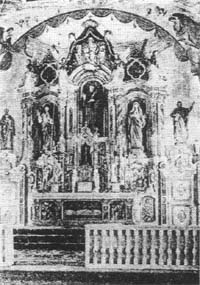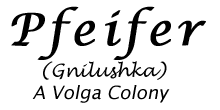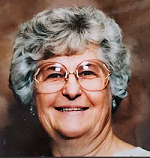
Pfeifer Village Website
"Gnilushka", Volga River, Bergseite, Russia
Pfeifer Village History

Also know as "Gnilushka"
Pfeifer was founded June 15, 1767 by German emigrants from Baden,
Wuerttemberg and other provinces in Germany.
Pfeifer is situated on the West side of the Volga River. On what is called the "Bergseite" (hilly side). It is on the west side of the Ilavlya River.
117 versts from the provincial capital, Saratov, 65 versts
from the district capital, Kamyshin, and 6 versts from the volost
centre, Kamenka. The general Russian census of 1788, Pfeifer had 89
families, with 270 males and 237 females. Since the founding, the
following have left the colony: in the years 1860-1864, 23 families
migrated to the province of Samara (probably Steckerau); in the years
1877-1886, 64 families went to South America; in the years 1868-1876
six persons were expelled from the community for immoral behavior and
were banished to Siberia. There are also 90 families, still belonging
to this community, who now have their homes elsewhere.
PFEIFER has been an independent Catholic parish since 1871. In the 1798
census the parishioners belonged to St. Mary's Catholic Church in
Kamenka where there was a priest as well as a church for worship. The
parish church was built of wood in 1846. There is a parochial school
where small children are taught reading, writing, and religion by a
schoolmaster under the supervision of a priest. Since 1888 there was
also a government-supported Russian school. 618 adult males and 524
adult females are able to read and write. Church of St. Francis is no
longer standing.
The first priest serving St. Francis of Assisi at Pfeifer was Philipp
Dorzweiler. He was followed by Michael Haag 1869 -1877, Sebastian Wolf
1877-1878, [again] Philipp Dorzweiler 1878-1880, Johannes Burgardt 1880
-1894, Peter Mueller in 1887, Josef Paul 1897?-1898, [in 1897 Josef
Hein from Koehler attended to the needs of the parish at Pfeifer], in
1904 Alexander Staub of Kamenka served Pfeifer, Joseph Guetlein in
1905, Johannes Fix 1905 -1909/1910, Johannes v. Pauer 1890 -1905?,
Joseph Beilmann 1911-1913, Nikolaus Maier 1914 -1918, Emanuel Simon
?-1921, and Leo Weinmayer 192l -1928.
The colony has the following artisans: 27 shoemakers, 4 cabinetmakers,
5 wheeelwrights, 2 weavers, 7 carpenters, 4 tailors, 2 oven-builders, 8
blacksmiths and l musician. It also has an oil-mill, 2 wind-driven
flour mills, 21 establishments dealing in manfactured goods, 4 small
shops and 3 liquor stores.
The land owned by the community has an area of 11,979 dessiatines, of
which 8,195 are under cultivation, 150 hayland, 245 are wooded, 265 are
pasture, 6 are seeded to hemp, 37 are potato field, 6 are cabbage
field, 126 are occupied as village lots and vegetable gardens and 45
are used for threshing-floors. The surface of the land is mostly hilly.
Of the total area, 450 dessiatines have good black soil, the rest is
mainly clay with sandy subsoil. On the land are seven dams for the
watering of livestock. The land is divided among the families according
to the number of males.
The colonists sell their produce mainly in Nishnaja-Panovka [Hildman]
on the Volga, less frequently in the district capital, Kamyshin.
1 verst = 2/3 mile. 1 dessiatine = 2.7 acres
Today the village of Pfeifer is an unpopulated city of ruins,
except for a small store.
Source:
AHSGR Work Paper #16 (December 1974)
1798 Revision List (Census)
DIE KIRCHE AND DAS RELIGIOSE LEBEN DER RUSSLANDDEUTSCHEN by Joseph
Schnurr
 |
Built of wood in a neoclassic style, the church contained a high altar, side altars and organ that came from the South Tyrol. The upper half of the interior walls were whitewashed whereas the lower half were finished in light blue. |
 |
The ornate wood carvings of the high altar
|


